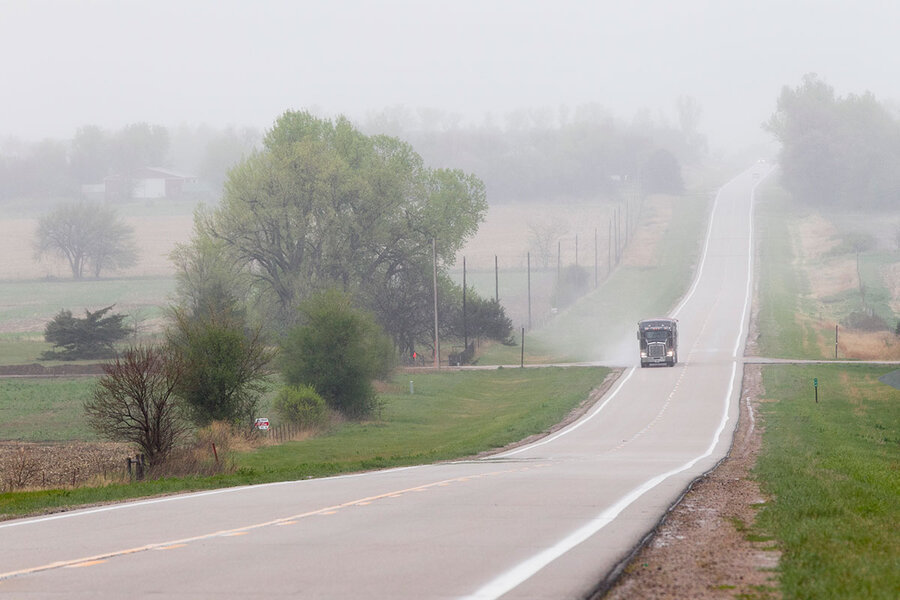Need a ride in farm country or in a distant exurb? How one company wants to help
Loading...
In cities such as Boston or San Francisco, getting a ride around town from a Lyft or Uber has become somewhat intuitive for urban dwellers. Now one company is trying to see if that model will translate to rural America where giving rides to friends and neighbors has long been part of the social fabric.
The ride-sharing service Liberty Mobility Now, which just passed its one-year anniversary, is offering rides in Nebraska, Texas, and Ohio to those underserved by current transportation systems. Liberty hopes to continue to expand to seven new states this year. The goal is not to replace existing public transit systems or taxis, says company founder Valerie Lefler, but to "fill in the gaps" for shorter trips, such as to a local bus stop or rides around town if the only family car is in the shop. But Liberty also aims to bring a more "altruistic" approach to the ride-sharing model by focusing on building a customer base among passengers with special needs and pairing them with drivers especially trained to meet those needs.
“We actively recruit folks who volunteer for [organizations] like the Red Cross ... that are already in this service and doing it for friends or family but maybe just don’t have enough money to be able to do that for everybody,” Ms. Lefler tells The Christian Science Monitor.
This "shared-mobility" approach, meaning it complements existing transit options, is one of several emerging efforts seeking to solve transportation challenges in small cities across the country, says sustainable transportation expert Susan Shaheen at the University of California at Berkeley. However, unlike similar volunteer-based programs that support the elderly and those with disabilities the Liberty model wants its drivers to earn wages.
“We are really just starting to investigate this topic,” says Dr. Shaheen, the co-director of Berkeley's Transportation Sustainability Research Center. “[We] are trying to understand how could we evolve this range of services … and transfer them to more suburban and more rural environments in a way that can really help extend the range of choices and the accessibility transportation for much wider range of individuals.”
For the nearly 4.2 million rural households in the United States that don’t own a car, options for getting around can be limited: Public transit is almost nonexistent, and cab rides are too costly for day-to-day needs. This is where Liberty wants to step in. By using its app or dialing the call center, customers can hire a driver and car for as little as $1 per mile after a $1.25 booking fee, with the choice to share the ride with another passenger.
In addition to providing passengers with on-demand service, Liberty also works with existing transportation services, including taxi, shuttle, and public transit, to both connect drivers with more riders and to connect riders with public transit terminals, similar to models that Lefler says have already taken off in Europe. For instance, a Finnish app called "Whim" that is still in beta links all bus, train, bike, taxi, and ride share programs so car-free users can buy a complete mobility package in one place to ensure smooth transitions for their trip.
“[W]e are heralded as one of the rural ride-share programs, but our main mission is mobility as a service,” Lefler tells the Monitor. “We really aim to connect individuals with all types of transportation.”
Sharon Feigon, the executive director at the nonprofit Shared Mobility Center in Chicago, echoes that sentiment, saying there are enormous needs in rural areas, where its low-density makes it costly to have traditional transportation methods, yet is greatly needed for the residents.
“Having transportation can make the difference between having a job or not having a job,” she says.
But more importantly, services like Liberty also serve a usually overlooked population: those no longer able to drive or with disabilities, especially individuals who might not need a special vehicle, Ms. Feigon points out.
“There are a lot of people who need extra help but they don't need a wheelchair-accessible vehicle, and transit agencies, for the most part, are providing this most expensive option for anybody who needs extra help,” she says. According to the latest report from the Government Accountability Office, the average cost for a para-transit trip is estimated to be $29.30 nationwide. But Lefler says the costs per person can be steep as well, as each trip might cost as much as $2 to $4 per mile with only a handful of people on the bus.
Especially with para-transit being expensive and requiring a booking days ahead of the trips, Feigon says the new ride-share program fills in the needs of those who need to travel with a short notice but don’t necessarily require a special vehicle.
Rebecca Harlan, a resident in Van Wert County, Ohio, is such an example. Working as the Head of Circulation at the Brumback Library, Ms. Harlan says she doesn't drive because of health issues and has been relying on family members or friends to get home from work every day. She recently heard about the launch of the Liberty service in her town and decided to give it a try.
Harlan says she enjoyed the experience greatly, saying that she happened to know the driver, who also assisted her in getting into the vehicle.
"They use local people to staff it. It just so happened I knew the driver," she says. "I felt very comfortable from the beginning."
Citing the easy process to order a ride and its inexpensive price, Harlan says she will continue using Liberty in the future and will recommend others to try it as well.
With this demographic in mind, Lefler says Liberty not only provides passenger assistance training for its drivers, but is also actively recruiting individuals who want to make a difference and give back to their community. Unlike other ride-hailing companies, which tend to encourage their drivers to work full-time, Liberty’s drivers usually don’t solely depend on the income to make a living.
For Josh Roberts, a Liberty driver in Van Wert County who has been helping an elderly neighbor get around, the program is a great fit for him to continue doing the work but also get some compensation.
"I have a disabled child and I know how hard it is to help him to get around and things," he tells the Monitor. "Just other people in the community need help also.... I like being able to help them if I can."
The altruistic aspect of the program, according to Lefler, has been a major reason that Liberty has been welcomed by many rural communities – it fits in with long traditions neighbors helping neighbors. It's also an important component that enables the young company to receive grant funding from both the federal and local governments, among other sources of endowment.
Yet, noting the different model Liberty has in the ride-hailing market, Evan Rawley, a professor of business at Columbia Business School in New York City, says the markets of Liberty might still be too limited for further growth, considering the low density in the suburbs.
“That's both an opportunity and a threat for a company like this, because I can see them generating a bigger network than what the taxi firms have already, but that means they are probably going to be vulnerable to somebody like Uber and Lyft in the long run.”
Lefler is optimistic about the prospects of Liberty, however. With Wales and Australia already reaching out, the company is looking to operate both nationally and internationally by 2020.
“We're still a young company, but we're looking to scale,” she says. “We have additional communities, countless folks reached out to us, saying, ‘We're ready for our community to be next.’ And we take each opportunity very seriously.”








